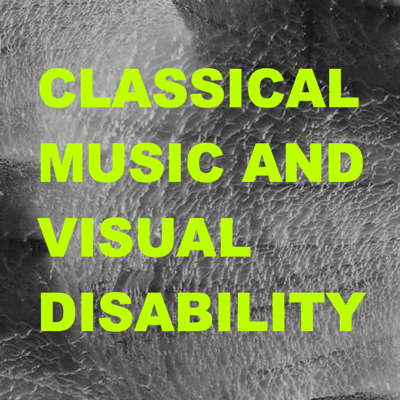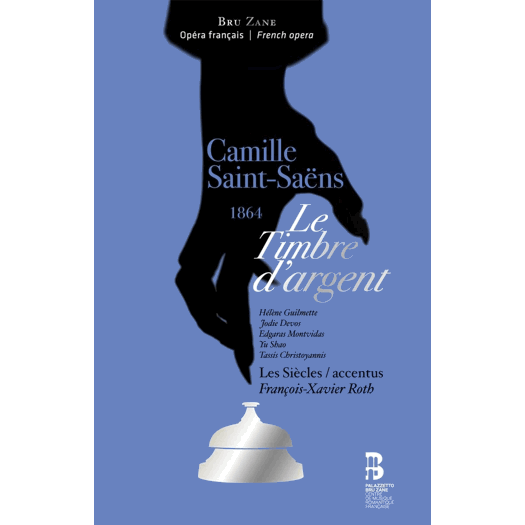- Grace Bumbry
- Florida
- Beethoven
- Joel Krosnick
- Francesco Passarini
- Iain Clarke
- Carl Schimmel
- Grimethorpe Colliery Band
 SPONSORED: DVD Spotlight. Olympic Scale - Charles Gounod's Roméo et Juliette, reviewed by Robert Anderson.
SPONSORED: DVD Spotlight. Olympic Scale - Charles Gounod's Roméo et Juliette, reviewed by Robert Anderson.
All sponsored features >>
 PODCAST: John Dante Prevedini leads a discussion about Classical Music and Visual Disability, including contributions from Charlotte Hardwick, Robert McCarney, Halida Dinova and Giuseppe Pennisi.
PODCAST: John Dante Prevedini leads a discussion about Classical Music and Visual Disability, including contributions from Charlotte Hardwick, Robert McCarney, Halida Dinova and Giuseppe Pennisi.

A Multifaceted Intellectual
GIUSEPPE PENNISI listens to Saint-Saëns' opéra fantastique 'Le timbre d'argent'
'From the very start of the overture, the listener feels that this is a brisk and expert ensemble.'
Charles-Camille Saint-Saëns was born in Paris on 9 October 1835 and died in Algiers on 16 December 1921. The one hundred and fiftieth anniversary of his death will be celebrated next year. The Palazzetto Bru Zane - Centre de musique romantique française will be at the forefront in organizing a festival in Venice, Paris and other cities. As an appetizer, it has produced the world's first recording of Le timbre d'argent, an opera composed in 1865 but premiered only in 1877 and revived, even though revised, in 1913 for a production in Brussels as well as for a production at the Opéra Comique in Paris in 2017.
Saint-Saëns was a multifaceted intellectual. From an early age, he devoted himself to the study of geology, archaeology, botany and entomology, in addition to music. He was also an excellent mathematician. Later, alongside his work as a composer, performer and music publicist, he devoted himself to the most varied disciplines, engaging in discussions with the best scientists in Europe and writing papers and even books on acoustics, occult sciences, decorations in the theatre of ancient Rome and ancient instruments. He also wrote a philosophical work, Problèmes et mystères, which deals with how science and art can replace religion; Saint-Saëns' pessimistic atheist's view anticipated Existentialism. On the literary side, he published a volume of poems entitled Rimes familières and the farce
Now, his name as a musician circulates mostly for his Le carnaval des animaux, for Danse macabre, for his organ symphonies and for his piano and cello concertos. His opera Samson et Dalila is often staged as a colossal in open theatres in the Summer and obscures all his other operatic works. Saint-Saëns wrote twelve operas, two of which are opéra comique. During the composer's lifetime, his Henry VIII became a repertory piece; since his death only Samson et Dalila has been regularly staged, although according to Schonberg, Ascanio (1890) is considered by experts to be a much finer work. Saint-Saëns's biographer James Harding comments that it is regrettable that the composer did not attempt more works of a light-hearted nature, on the lines of La princesse jaune, which Harding describes as like Sullivan 'with a light French touch'.
Le timbre d'argent (The Silver Bell) is an opéra fantastique in four acts to a French libretto by Jules Barbier and Michel Carré, the same team that wrote the librettos for Gounod's Faust and for Offenbach's Les contes d'Hoffmann. Le timbre d'argent is the first opera that Saint-Saëns composed. The work's premiere was delayed, first by the financial difficulties of the opera house and then later by the Franco-Prussian War. Over the next twelve years, Saint-Saëns recomposed the dialogue to form a grand-opéra version, but the Théâtre National Lyrique, who finally staged it, decided to use the original 1865 rendition for the opera's premiere in 1877. The grand opera version was first performed in 1913. The CDs opt for the final version, as revised for Brussels' Théâtre de la Monnaie, because it contains the most music since it replaces the dialogues with recitative. Only one number is cut: the waltz for orchestra in the last act. The recording is based on the revival of the work at the Opéra Comique in 2017 where the waltz was cut for theatrical reasons and could not be reinstated.
The plot is quite simple. Conrad, an artist, has an unhealthy obsession for gold, and he is further engrossed by his own painting of Circe, embodied in the living world by Fiametta, a ballerina. Conrad is given a silver bell by Dr Spiridion: when he strikes the bell he will receive all the gold he craves for, but at the cost of someone's death. The opera concludes with the realization that all of the events have only occurred within Conrad's own fevered mind.
Like Gounod's Faust and Offenbach's Les contes d'Hoffmann, Le timbre d'argent explores the hero's reliance on a menacing older man imposed by a diabolic pact. The character of Conrad is similar in many ways to that of Hoffman in Offenbach's opera, and the villainous character of Dr Spiridion corresponds well to Offenbach's villains - Lindorf, Coppélius, Dapertutto and Dr Miracle.
The music of Le timbre d'argent is both versatile and fluent. The drama at times poses difficulties, especially the mimed part of Fiametta and the somewhat weak revelation of truth at the opera's end. However, there are several effectively bold scenes such as a theatre viewed from the back of the stage and a number of imaginative transformations. A number of the positive aspects of this opera undoubtedly influenced Offenbach's Les contes d'Hoffmann, as his first focused efforts on composing Hoffman took place during the first eighteen performances of Le timbre d'argent in 1877.
The Opéra Comique and the Palazzetto Bru-Zane Centre de musique romantique française coproduced the 2017 revival that is at the basis of this CD set. The orchestra is Les Siècles, with the choir Accentus conducted by François-Xavier Roth. From the very start of the overture, the listener feels that this is a brisk and expert ensemble.
Listen — Saint-Saëns: Ouverture (Le timbre d'argent)
(CD1 track 1, 0:00-0:48) © 2020 Palazzetto Bru Zane :
This is confirmed through the rendering, especially in the concertato of the final section.
Listen — Saint-Saëns: Scène finale (Le timbre d'argent Act IV)
(CD2 track 23, 1:22-2:04) © 2020 Palazzetto Bru Zane :
The opera's main characters – Hélène, sung by Hélène Guilmette, her sister Rosa, sung by Jodie Devos, Conrad (Edgaras Montvidas), his friend Bénédict (Yu Shao) and the devilish Spiridion (Tassis Christoyannis) - are introduced skilfully in a scene and chorus at the beginning of Act I.
Listen — Saint-Saëns: Eh bien? (Le timbre d'argent Act I)
(CD1 track 3, 0:10-1:07) © 2020 Palazzetto Bru Zane :
The listener acquaints himself with a young but valiant cast of singers. It is soon clear that the three protagonists are Conrad, Hélène and Spiridion.
The lyric tenor Edgaras Montvidas has an excellent entry aria.
Listen — Saint-Saëns: Dans le silence et l'ombre (Le timbre d'argent Act I)
(CD1 track 11, 0:05-0:46) © 2020 Palazzetto Bru Zane :
And there is a superb scene with chorus when the plot unravels.
Listen — Saint-Saëns: Quelle invisible main me pousse (Le timbre d'argent Act IV)
(CD2 track 13, 0:01-0:59) © 2020 Palazzetto Bru Zane :
The two sopranos, Hélène Guilmette and Jodie Devos, start with a very mystic prayer.
Listen — Saint-Saëns: Ô Vierge mère (Le timbre d'argent Act I)
(CD1 track 6, 0:01-0:41) © 2020 Palazzetto Bru Zane :
This is followed by a romance by Hélène Guilmette that became a favourite concert piece.
Listen — Saint-Saëns: Le bonheur est chose légère (Le timbre d'argent)
(CD1 track 20, 0:21-1:21) © 2020 Palazzetto Bru Zane :
While Rosa/Devos is mostly in duets and ensembles.
Spiridion/Christotannis does not have a number only for himself but his devilish touch is throughout the four acts of the opera, mainly in his duet with Conrad/Montvidas (and chorus) at the fourth act. A real showdown.
Listen — Saint-Saëns: À moi! filles d'enfer (Le timbre d'argent)
(CD2 track 17, 0:00-0:20) © 2020 Palazzetto Bru Zane :
It is hard to foresee whether, after the revival in Paris, Le timbre d'argent will enter the repertory. This does seem the time for opéra fantastique. Some fifteen years ago, the Opéra du Rhin in France and the Teatro Lirico di Cagliari proposed two different but excellent productions of Hans Heiling by Heinrich Marschner; they were praised by reviewers and played to sold out houses, but there was no further revival outside the German speaking opera world.
I hope that Le timbre d'argent may have better luck.
Copyright © 20 September 2020
Giuseppe Pennisi,
Rome, Italy

CD INFORMATION - CAMILLE SAINT-SAËNS: LE TIMBRE D'ARGENT
FURTHER ARTICLES ABOUT CAMILLE SAINT-SAËNS
FURTHER INFORMATION ABOUT PALAZZETTO BRU ZANE


